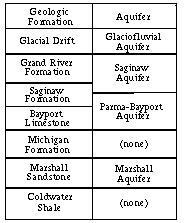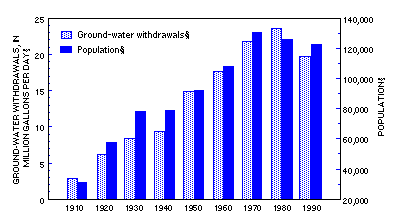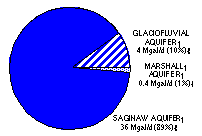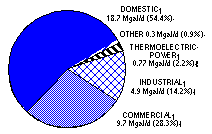
Ground-Water Withdrawals in Clinton, Eaton, and Ingham Counties, Michigan,
1995
By:
Luukkonen, C.L.
Abstract
Table of Contents
The Tri-County region includes Clinton, Eaton, and Ingham Counties in the south-central Lower Peninsula of Michigan (fig. 1). People in the Lansing Metropolitan area, which is located near the center of this region, generally enjoy high-quality drinking water. In fact, taste testers ranked Lansing's water as second in the Nation at the 1988 American Water Resources Association Water-Use Symposium in Tucson, Arizona. However, a drought in 1988 and subsequent water rationing within the Tri-County region prompted local communities to assess the adequacy of water resources for future needs. As part of that effort, this fact sheet provides a brief overview of the development of ground-water resources within the region.

Figure 1. Clinton, Eaton, and Ingham Counties, Lower Peninsula of Michigan.
Ground water is the primary source of water for domestic, commercial, and industrial use within the Tri-County region. The ground-water resource originates from precipitation that infiltrates into the soil and percolates through underlying geological materials into permanently saturated rock formations beneath the earth's surface. Those saturated rock formations that readily transmit water to pumping wells are referred to as aquifers. In the Tri-County region, there are four aquifers associated with seven geologic formations (fig. 2).

Figure 2. Geologic formations and aquifers that underlie
the Tri-County region (modified from Westjohn, Weaver, and Zacharias,
1994).
Historically, trends in ground-water withdrawal rates have followed changes in population. In the City of Lansing, the peak ground-water withdrawal occurred in 1980 (fig. 3). Within the region, data from 1992 indicate that a total of 49.6
Mgal/d (million gallons per day) of ground water was withdrawn, of which 40.4
Mgal/d was withdrawn by public water-supply systems and 9.2 Mgal/d was withdrawn by self-supplied users. These withdrawals provided water for 318,000 people who depend on public water supply and 115,000 who are self-supplied. This corresponds to an average daily ground-water use of 116 gallons per person per day for domestic, commercial, and industrial use. Imagine, if this water were being withdrawn from Lake Lansing, this lake, which contains 1,330
Mgal, would be dry in less than 1 month.

Figure 3. Ground-water withdrawals and population values
for Lansing, Michigan.
About 4 Mgal/d was withdrawn from the glaciofluvial aquifer for public supply in 1992 (fig. 4). Glaciofluvial deposits were formed by continental glaciers, or meltwater from the glaciers. Aquifers are generally associated with these coarse-textured materials. Glaciofluvial deposits underlie most of the Tri-County region and range from 0 to 200 ft in thickness. The glaciofluvial deposits are thickest in the northern part of the Tri-County region. Ground water from glaciofluvial aquifers is withdrawn primarily by domestic wells.

Figure 4. Source of water for public supply systems.
About 36 Mgal/d was withdrawn from the Saginaw aquifer for public supply in 1992. The Saginaw aquifer is composed of the Grand River Formation and part of the Saginaw Formation and consists primarily of sandstone. The Saginaw aquifer underlies most of the Tri-County region and ranges from 0 to 300 ft. in thickness. This aquifer is the principal source of water for Tri-County residents. In 1992, more than 89 percent of the ground water withdrawn by public systems and more than 90 percent of the ground water withdrawn for self-supplied use was withdrawn from the Saginaw aquifer.
No water was withdrawn from the Parma-Bayport aquifer for public supply in 1992. The Parma-Bayport aquifer is composed of part of the Saginaw Formation and the Bayport Limestone and consists of limestone and sandstone. The Parma-Bayport aquifer ranges from 50 to 100 ft in thickness. Wells in the Parma-Bayport generally provide sufficient water for domestic needs in the southwestern part of Eaton County.
About 0.4 Mgal/d was withdrawn from the Marshall aquifer for public supply in 1992. The Marshall aquifer consists primarily of sandstone. The Marshall aquifer extends throughout the entire Tri-County region and ranges from 100 to 150 ft in thickness. The Marshall aquifer is an important source of water to domestic wells where it is overlain by glaciofluvial deposits in the southwestern part of Eaton County. Through-out the rest of the Tri-County region the Marshall aquifer yields saline (salty) water. No aquifers that contain usable water are present within the Coldwater Shale or lower formations.
Ground-water withdrawals from large public suppliers (those withdrawing more than 0.88
Mgal/d in 1992 or from those who served more than 8,000 people) were categorized by use based on information provided by the public supplier. About 34.4
Mgal/d (85% of the total) of ground water was withdrawn in 1992 by large public suppliers in the Tri-County region and used for a variety of uses, including domestic, commercial, industrial, and thermoelectric power generation (fig. 5). The largest public-supply deliveries (54.4%) were for domestic use. An additional 9.2
Mgal/d was withdrawn for self-supplied domestic use.

Figure 5. Public supply delivery.
Publication
Luukkonen, C.L., 1995, Ground-Water Withdrawals in Clinton, Eaton, and Ingham
Counties, Michigan: U.S. Geological Survey Fact Sheet 226-95, 2 p.
Back to
Publications List
Back to USGS, WRD Michigan Home Page
U.S. Department of the
Interior, U.S. Geological
Survey
Maintainer: Webmaster
<gs-w-milns_webmaster@usgs.gov>
Updated On: Tuesday, September 26, 2000
Privacy Statement ||
Disclaimer
URL: http://mi.water.usgs.gov/reports/text.wufs.html





